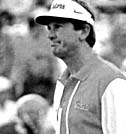

| |

Inside the mind of our most daunting opponent
by Brooks Clark
Steve Spurrier really bugs UT fans. He brags about how his speaking fees have gone up. Three years ago his sanctimonious attitude goaded Phil Fulmer into calling him "Saint Steve." Most annoying of all, Spurrier's "Fun & Gun" offense has averaged 320.6 yards passing per game in his 11 years as a head coach, and in his eight seasons in the SEC, he has become the winningest coach (by percentage, at .887) in conference history.
Spurrier's a great head coach and a peerless offensive strategist, but his true love—what he does better than anything else and better than anyone else—is being the Lee Strasberg of quarterbacking. Spurrier loves to teach quarterbacks.
What is the Spurrier method? Metro Pulse posed the question to a former pupil, Ben Bennett, who learned his craft from Spurrier at Duke in the early '80s and has gone on to a long career in arena football, most recently with the Portland Forest Dragons. In Bennett's time at Duke, Spurrier was the offensive coordinator and quarterbacks coach.
"First," says Bennett from his home in Orlando, "you don't even get to the mental stuff until you undergo a stiff regimen of fundamentals. If you are not a fundamentally sound quarterback, you will not be effective in a Steve Spurrier offense. It's the feet, the head, the placement of the body and hips, the depth of the drop. All the things that people take for granted, Steve pounds into you from day one. It's little things that matter, because your feet and hips control everything the rest of your body does.
"So, I'd do 150 drops after every practice. As an 18-year-old smart-ass from California, I couldn't see it as anything but punishment. But without that I wouldn't have done the things I've been able to do. It's like learning to drive a four-speed transmission. At first you look down at the pedals. Once you've done it awhile, it becomes second nature and you can do it without looking. But you've got to get it all down to the point that you're not thinking about it.
"So, once you've done that, if you're not a complete basket-case by that time, then you begin to learn Steve's system and decision-making skills. Each play in Steve's system is designed to attack various defenses. You have to know what your options are. Eighty percent of the time it's either A or B. If they take away A, they can't take away B. The key is knowing the defenses that you'll be facing, knowing how your offense will attack their defenses. It takes a long time to learn that system.
"I feel that over the years, Steve has learned a lot about how to teach his offense. As an 18-year-old, I found that playbook daunting at best. He used to introduce a huge amount of offense in a short period of time. Now, instead of trying to teach the quarterback the whole offense, he wants you to get the philosophy, which is you take your five steps, you set up, you let it go. Before the snap, you know what defense you're looking at, what play to call against it, and what your options are going to be. After the ball is snapped, it's almost always an A-B-C read. You look at option A, option B, then option C. If C's not open, you throw the ball away. Rarely will you look from one side of the field to the other side of the field the way pro quarterbacks do. Last year Danny Wuerffel was probably frustrated at having to hold the ball in the backfield as you often do in NFL offenses, hanging back there and allow the play to develop.
"The way Steve teaches decision-making is through repetition. You have to be smart and you have to take reps. If you're going to be put in a situation that you're surprised, then you react to that situation. Where you have a pretty good idea of what's coming, you're better prepared to attack that situation. In film sessions, Steve will sit down and explain to you what he sees. You look at your own films—what you have or haven't done. Soon you begin to see the same things. You are prepared to make your decisions, and through repetition you improve your ability to make those decisions.
"In Steve's offense, everybody gets to throw and catch the ball. Receivers throw the ball. Running backs throw the ball. Quarterbacks catch the ball. [At Duke, Bennett once caught one for a touchdown.] It's razzle-dazzle. Steve likes to make the game fun. You get everybody on the team involved in the game and people get excited.
"And he has new ideas all the time, at any time, you never know. At a team meal right before a game, he'll start moving salt and pepper shakers and pushing around the oatmeal and working up a new play. Once before Wake Forest, he put in a play in which our tailback started out on a sweep, then stopped and passed deep. Steve had a hunch that Wake Forest's strong safety—that particular individual—would come up a little too early to stop the sweep, and he was right. It worked twice for touchdowns. Not every one of Steve's ideas work. But nine out of 10 times, when you do what he says, the thing happens.
"Steve's philosophy is to be totally prepared, to know exactly what you're going to do, and then, at game time, to enjoy it. Once all is said and done, it's a game and you want to have fun."
 |